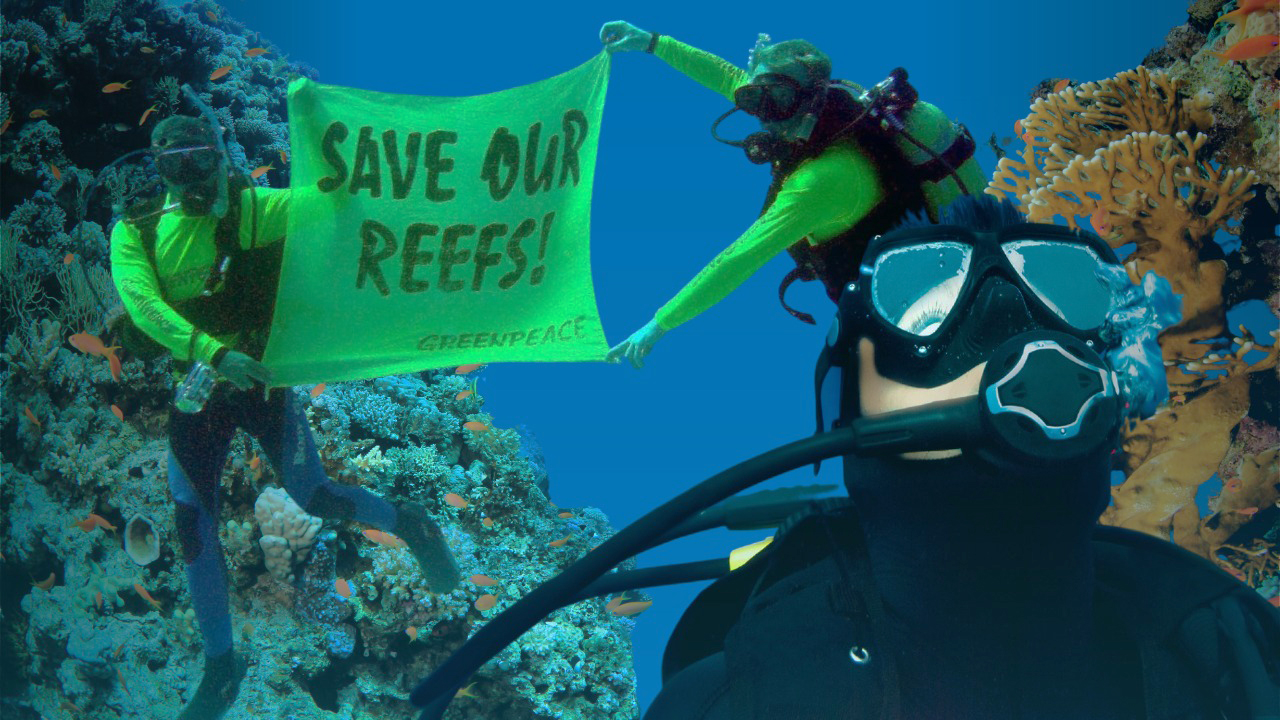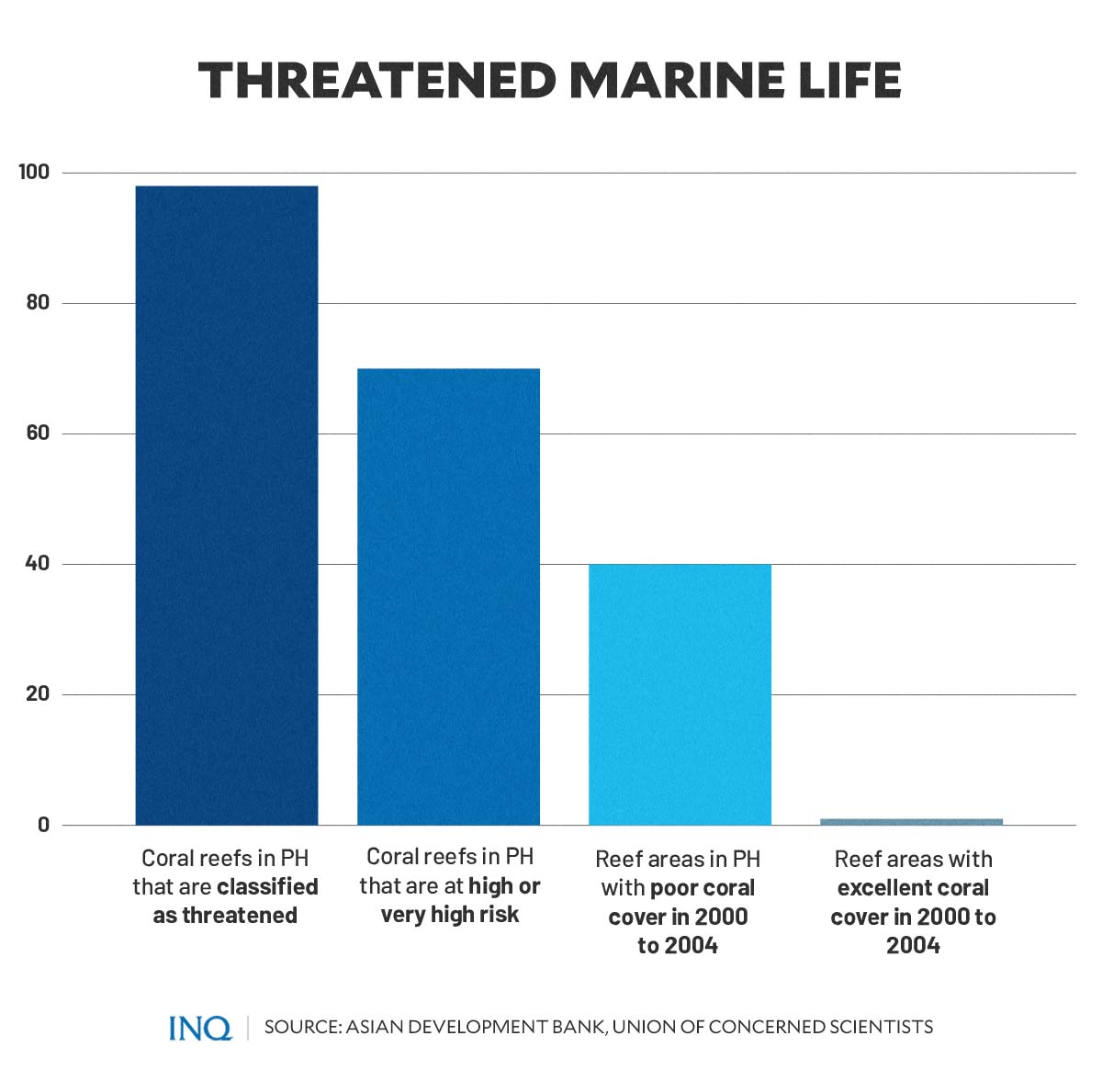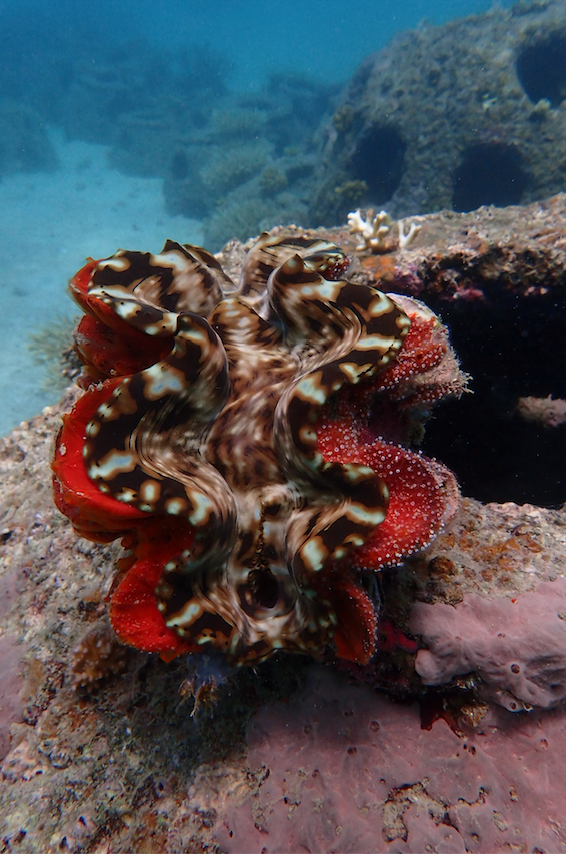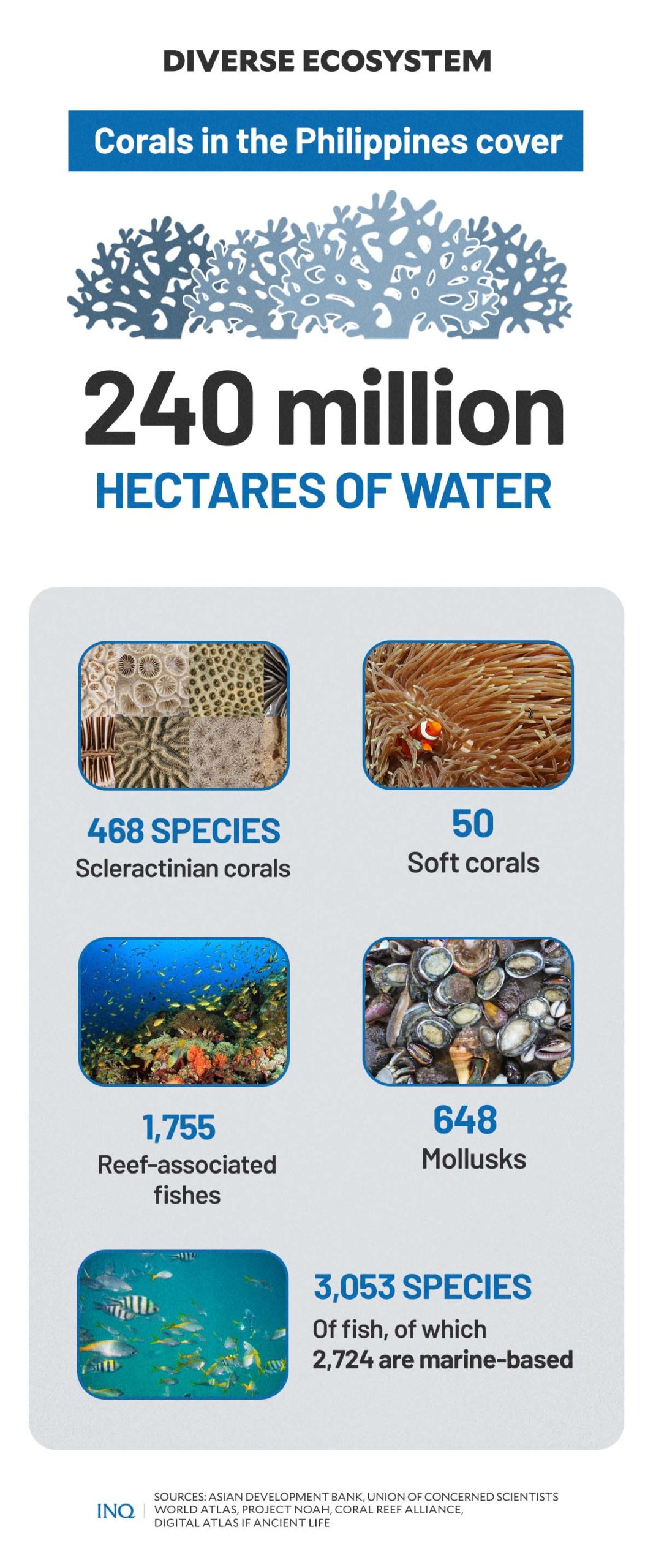Dying Masbate marine ecosystem revived as PhilGold deploys thousands of reef balls

COMPOSITE IMAGE Daniella Marie Agacer
MANILA, Philippines—“Dying.”
This was how the Department of Environment and Natural Resources (DENR) described the coral cover in the coastal communities of Aroroy town in Masbate province which were heavily destroyed by decades of illegal fishing.
The DENR regional office in Bicol said in 2019 that of the 129-hectare marine ecology, only 12 percent of living coral cover were spared from years of “neglect and abuse.”
RELATED STORY: Reef alert
With corals that cover 240 million hectares of water, the Philippines’ coral reef system is the second largest in Southeast Asia and is home to 468 species of scleractinian corals, 50 soft corals, 1,755 reef-associated fishes, and 648 mollusks.

GRAPHIC Ed Lustan
However, as the DENR said, the coral reefs—rainforests of the sea—in Aroroy, Masbate is a “replica” of almost all coral covers in the country: heavily destroyed by “destructive fishing, overfishing, sedimentation, and ill-planned coastal development.”
Article continues after this advertisementAs the Asian Development Bank stressed, reef areas with poor coral cover accounted for 40 percent of world total in 2000 to 2004. Conversely, reef areas with excellent coral cover comprised less than one percent.
Article continues after this advertisementRELATED STORY: Groups strengthen efforts to protect ‘pawikan’ nesting site, coral reefs in Subic Bay
The Union of Concerned Scientists said some 98 percent of coral reefs in the Philippines was classified as threatened, with 70 percent at high or very high risk. The main reason for the degradation? Blast fishing.
Ray of hope
But the DENR said a ray of hope emerged in 2013 as the Phil Gold Processing & Refining Corporation (PGPRC), a gold processing company in Masbate, started an environmental restoration initiative.
The PGRC eventually partnered with the local government and the Mines and Geosciences Bureau’s regional office in Bicol to establish the Colorada Marine Protected Area (MPA) in Barangay Tigbao.

GRAPHIC Ed Lustan
Municipal Order No. 031-2017 was signed on Sept. 12, 2017 in a bid to revive the coral cover in the coastal communities near Port Barrera to help Aroroy’s marine resources recover and to provide livelihood to residents.
Five years later, the protected area off the island in Masbate witnessed a “return to life” of coral reefs, following the steady deployment of close to 3,000 reef balls in a “determined bid to rehabilitate” the coral cover.
One of eight species of giant clams in the Philippines—tridacna squamosa—was recently sighted at the Colorada MPA where PGPRC deployed 2,743 reef balls. Two more species of giant clams—tridacna maxima and tridacna gigas—were also seen.

Tridacna squamosa, one of the eight species of giant clams in the Philippines, with the reef balls planted by PGPRC in the background. PHOTO FROM PGPRC
The PGPRC said tridacna maxima and tridacna gigas were found to be “natural recruits,” indicating that the reef is coming back to life. Aside from the 2,743 reef balls, the PGPRC also propagated and planted 40,482 coral fragments.
“To complement the rehabilitation of the MPA, PGPRC is also conducting a mangrove reforestation program and has planted over half a million mangrove seedlings—510,000 to be exact—covering an area of approximately 115 hectares,” it said in a statement.
The construction and deployment of the reef balls started in 2017 in tandem with the US-based Reef Ball Foundation (RBF), a non-profit environmental organization with a mission to rehabilitate ocean reef ecosystems and to protect the natural reef systems.
Reef balls
The foundation said a reef ball is a designed artificial reef module that “mimics” the structure and function of a natural reef, which provides a significant ecosystem for marine life and coastal communities.
Reef balls are made of a special marine-friendly concrete and used all over the world to create an ecosystem for marine species. Reef balls are made in many sizes to best match the natural reef type.
RBF said the reef balls function better when they mimic nature and the number and placement of holes can be altered for each unit to create a variety similar to that found in nature and surface textures enhance marine life settlement.
It stressed that while the reef balls appear low-tech, they have been proven in thousands of initiatives as their environmental uses have been developed over the years and demonstrated to be effective and ecologically sound.
“Designed to withstand movement, reef balls have remained stable and undamaged in the highest-rated storms. Organic in appearance yet high tech in design, reef balls are proven solutions to a variety of marine environmental issues,” RBF said.
The RBF, which has engaged in over 3,500 initiatives, has so far deployed over 500,000 reef balls in 59 countries.
It said reef balls can easily be made and deployed even in areas with limited resources. “We intentionally developed the system to use construction tools and products which can be found anywhere and volunteers can easily learn the techniques.”
The Implementing Rules and Regulation of Republic Act 8550, or the Fisheries Code of the Philippines as amended by Republic Act 10654, define artificial reefs as any structure of natural or man-made materials placed on a body of water to serve as shelter and habitat, a source of food, breeding areas for fishery species and shoreline protection.
Save coral reefs
The DENR had said that “we must act now to save our remaining coral reefs, before it’s too late.”
This, as coral reefs are some of the most diverse ecosystems in the world, housing tens of thousands of marine species.
“Reefs buffer shorelines from waves and storms that cause flooding and erosion, support commercial and subsistence fisheries, and are home to a thriving recreation and tourism industry,” the DENR said.

GRAPHIC Ed Lustan
These coral reefs, ADB said, are home to 3,053 species of fish, of which 2,724 are marine-based. Pelagic fish species number about 177, while demersal species total 2,351 (1,658 of these are reef-associated and 693 are associated with other nearshore habitats).
The World Wide Fund for Nature said the latest estimates suggest that corals provide close to $30 billion in revenues each year from fisheries, tourism, and coastal protection.
ADB said reef degradation is the negative outcome of coastal development, marine-based pollution, sedimentation, overfishing, and destructive fishing practices.
In 2002, overfishing was the largest threat (about 40 percent) to coral reefs in the country, followed by destructive fishing practices (36 percent). However, by 2012, the threat posed by destructive fishing practices had decreased, though the intensity of the other threats had increased considerably.
For instance, some 2.2 million tons of organic pollutants are released into the country’s marine environment annually. The sources of this pollution include terrestrial-based domestic, agricultural, and industrial activities.